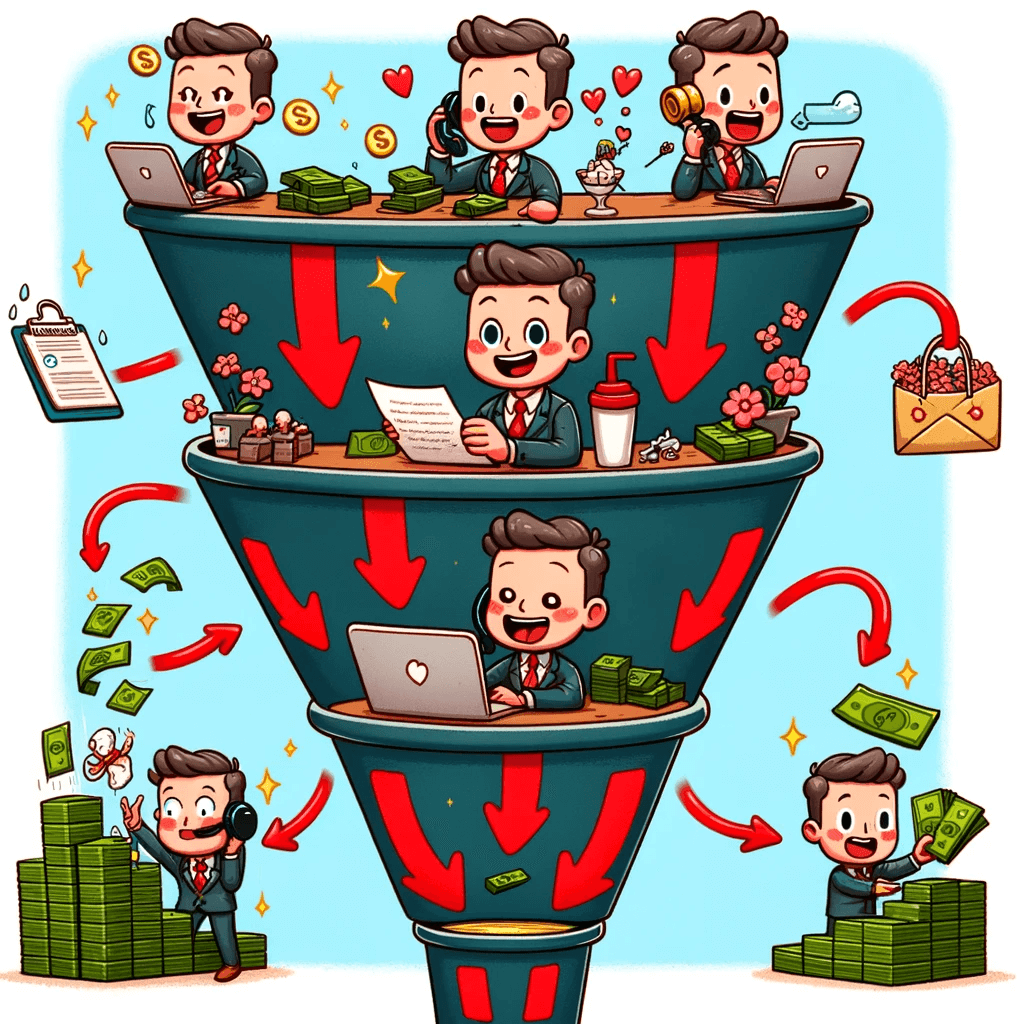This article is a refresher to anyone looking to build in sales - the current approach, terminology, key insights, challenges and opportunities available in this domain.

What is a sales funnel?
A sales funnel is the marketing term for the journey potential customers go through on the way to purchase. There are several steps to a sales funnel, usually known as the top, middle, and bottom of the funnel, although these steps may vary depending on a company's sales model.
A basic sales funnel can be described as consisting of 4 levels. Marketers can take inspiration from this basic structure to design a sales funnel that suits the needs of their organisation.
- Awareness: At the very top of the sales funnel is the awareness stage that is populated by the largest number of people. These people, not quite ready to be prospects yet, have just had their first interactions with your company and its offerings. They don’t know much about your brand at this stage, but are aware that it exists.
- Interest: The first interactions will hook some of these newly-aware people and draw them slightly deeper into the funnel. With their interest piqued, these people will spend some time getting to know more about your company and your offerings. They might browse your website or catalogue, read your blogs, or peruse reviews from past customers.
- Consideration: Armed with knowledge gathered during the interest stage, your prospects will double down on their efforts to know your company and offerings better. They may reach out to your customer service team with specific questions, or fill out a form to access more information. Remember, by this stage they may have already compared your offerings to those of your competitors. So, it is important to clearly answer their questions and help them understand how your offerings can solve their problems or needs.
- Negotiation and decision: The prospect has now almost decided to purchase your product or service. Depending on the nature of your offerings, they might begin a negotiation over the price, terms of purchase, or both. But it’s fair to assume that they have a purchase intention at this stage.
At the end of this stage —the prospect and seller have negotiated the terms of the sale to their mutual satisfaction, and the prospect pays the seller to officially become a buyer.
Extra - Renewal or repurchase: The sale stage is not the end of the sales funnel. Soon a time will come when the sales contract is up for renewal. The customer must now decide if they want to continue with the same seller. If so, there might be a fresh round of negotiations over price and purchase terms, followed by a renewal or repurchase.
Here's an image of the currently most widely used Sales tools and the stage of the funnel they're utilized in:

Why is a sales funnel imp?
That’s the value of knowing a sales funnel: Successful sellers understand the journey a prospect is likely to take before they buy, and can make sure they’re ready to move on to each stage. They’re focused on the buyer, meeting their needs in the moment and building trust that helps move the deal forward.
So what if you ditched the sales funnel? You’d run the risk of focusing too much on the close to hit quota, pushing products or services when prospects aren’t ready. Win rates would drop because prospects wouldn’t feel comfortable with the solutions they’re offered, and trust would be lost. No long-term relationships, no cross-sells, or upsells.
What challenges does sales have in 2023?
Challenge 1: Standing Out From the Competition
- To differentiate from others, salespeople should exceed prospects' expectations by being well-versed in their CRM and sales software, and staying updated with industry trends and news.
- Today, SaaS companies offer personalised email marketing, educational content, and in-depth exploratory calls with experienced representatives. Therefore, if you want to stand out from the crowd, you must be one step ahead of the already high standards of helpful, inbound selling.
- Gather sales enablement materials like industry specific demos, case studies, reviews, testimonials, and analytics tools or reports.
- Keep up with industry news, trends, and reports to help prospects guide strategy and show the potential ROI to their supervisors or other decision makers.
- Set up alerts and automation to help you follow up with prospects at the right time and provide valuable resources.
- Existing tools - Apollo.io, Outreach.io
- Opportunity: This presents an opportunity to innovate in personalized and inbound selling.
Challenge 2: Meeting Quotas
- A sales representative's best strategy for achieving quotas and converting leads is to make phone calls - whether they are selling remotely or not.
2. Two thirds of salespeople also use discounts and promotions, and more than half report that they increase sales. The most popular promotion among sellers is bundling a suite of products, followed by free trials.
Challenge 3: Getting in Direct Contact with Decision-Makers
- With remote work becoming prevalent, establishing a strong social media presence, particularly on LinkedIn, is crucial for connecting with decision-makers.
- In 2023, 67% of sales representatives worked under a hybrid or fully remote basis, and globally, almost 70% of professionals worked remotely. Many leaders and decision makers have physically moved to new locations farther away from their headquarters as industry events have largely shifted to virtual and hybrid formats.
- It's crucial that salespeople establish their own presence on social media if they haven't already done so. LinkedIn was rated as the most effective platform for prospect research by nearly three quarters of sales professionals.
Challenge 4: Lack of High-Quality Leads
- The first place to look when dealing with lead quality issues is sales and marketing alignment. Having a shared understanding of the ideal customer profile or buyer persona for sales and marketing teams is essential.
- Assess the lifetime value of customers and which ones turn into promoters in order to develop and update these assets.
- Using tools like LinkedIn Sales Navigator, HubSpot Sales Hub, LeadIQ, and others, sales teams find and engage with prospects at the right time after identifying target customers.
Challenge 5: Keeping Prospects Engaged Throughout the Sales Process
- It is important to understand your buyer in terms of the bigger picture context so you can keep their interest throughout the sales process, which can be lengthy depending on the software package or service you are selling.
- It is common for sales representatives to communicate with prospects two to seven times during B2B and B2C sales processes, which adds up when considering that most work with dozens of prospects at once.
- The use of automated sales management tools and CRMs with lead intelligence and logging of communications with prospects (such as phone calls, emails, and actions) can help sales teams manage hundreds of data points to successfully acquire new customers.
Challenge 6: Difficulty Getting Meetings With Prospects
- Timing is everything. Reach out at the wrong time, you’re a nuisance. Reach out at the right time, and you’re the answer to a prayer. It’s well known in the industry that the best salespeople spend most of their time on calls with prospects listening.
- In order to secure meetings with qualified prospects, the best strategy is to listen. And to make it easy to meet with you. When listening for signals that a prospect is ready to meet, use these questions as a guide:
- Social selling requires a combination of social media savvy and sales tools that can automatically flag key readiness indicators and send automatic alerts.
Key insights from 30+ interviews with sales and growth teams
Over the past 3 weeks, with conversations over 30 sales people, here are the key insights that stood out from my learnings in the current approach:
- Efficiency in Data Management: Many use tools like Excel and Salesforce for data organization, but there's a challenge in maintaining data hygiene and integrating personal notes effectively.
- Personalized Customer Engagement: Sales reps emphasize personalized interactions, like remembering personal details about clients and customizing outreach. This includes tactics like social media engagement, client lunches, and gift-giving.
- Utilization of Digital Tools: Sales teams heavily rely on digital tools like CRM systems, LinkedIn Sales Navigator, and calendar reminders for tracking client interactions and industry news.
- Challenges with Remote and Hybrid Sales: Adapting to remote and hybrid sales environments is a notable challenge, affecting how sales reps connect with decision-makers and clients.
- Importance of Relationship Building: There's a strong emphasis on building and maintaining relationships, seen as crucial in high-value sales.
- Adapting to Market and Client Dynamics: Sales reps must adapt to changing client personnel and market conditions.
- Efficient Use of Time and Resources: Balancing time spent on tasks like data entry and client engagement is crucial, especially in cold outreach and event networking.
Conclusion
In summary, the sales funnel remains a vital concept in the sales process, guiding potential customers from awareness to purchase.
In 2023, sales teams face challenges like standing out from the competition, meeting quotas, and effectively engaging with decision-makers, particularly in remote and hybrid work environments.
Utilizing digital tools like CRMs and LinkedIn, focusing on personalized customer engagement, and maintaining efficient data management are essential strategies. Building strong relationships and adapting to market dynamics are key to navigating these challenges.
Sales teams must balance innovative selling techniques with the efficient use of time and resources to succeed in the evolving sales landscape.


